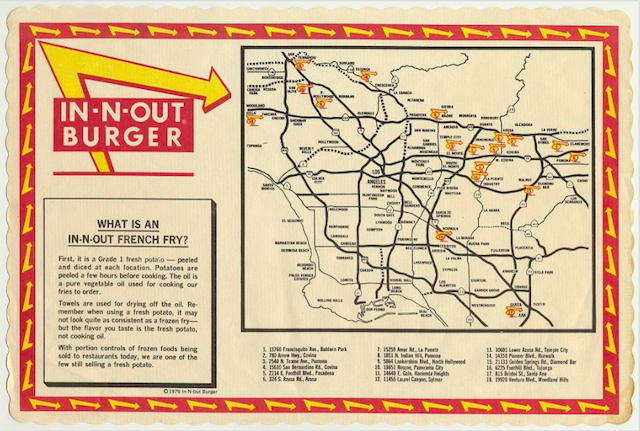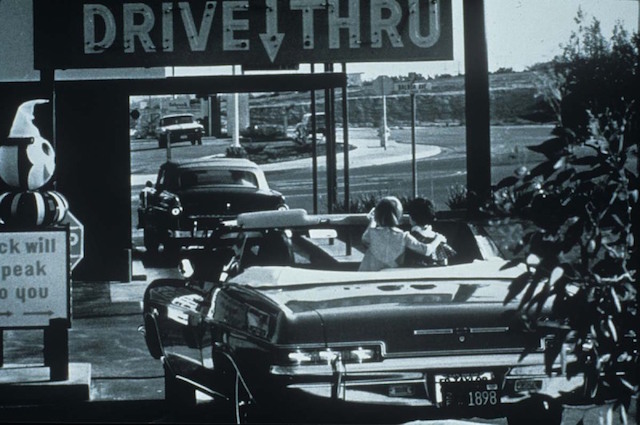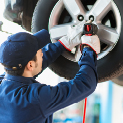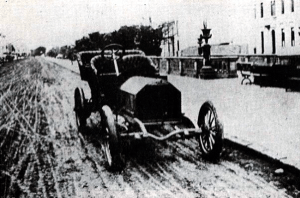Drive-thru history in America dates back more than 70 years. During that time, the concept has evolved drastically from a simple intercom system to mobile ordering and even the use of artificial intelligence.
But what is now ubiquitous at fast food restaurants as well as a host of other business, wasn’t always a common sight. So how did we get here? Let’s explore the history of the drive-thru window.
Precursors to the Drive-Thru
During the roaring ’20s, car ownership exploded. Everyday consumers were making more money in these pre-recession years and were able to afford vehicles. In turn, businesses such as drive-in movie theaters and restaurants became more popular.
Drive-in eateries date back to 1921 when a Texas chain of restaurants called the Pig Stand began incorporating the practice. At drive-ins, customers would park their car and immediately be met by carhops who would take orders and deliver them to the kitchen. When the food was ready, the carhop would bring it back to the car for the customer to enjoy in their vehicle.
This model improved the speed and efficiency of service. Restaurants continually tried to enhance the concept by increasing the speed at which the food could get to the customers. Hence the roller-skating carhops that became a popular trend across the country.

Drive-Thru History
The drive-thru was created in the 1940s. There are several claimants for the first such eatery, including Red’s Giant Hamburg on Route 66 in Springfield, Mo., which reportedly began the practice in 1947.
But the drive-thru as we know it today, complete with an intercom ordering system, started in 1948 at In-N-Out Burger in Baldwin Park, Calif.
The first In-N-Out location was barely 100 square feet – only enough room for the cooks. Owner Harry Snyder envisioned a concept that would enable customers to order and receive their meals without leaving their car. Working in his garage during late nights, Snyder created a two-way speaker box that allowed customers to do just that.
Surge in Popularity
The drive-thru model proved to be very successful. By 1958, In-N-Out had five locations in the Los Angeles area. Smaller chains like Jack-in-the-Box and Wendy’s adopted the model.
It wasn’t until the 1970s that drive-thru eating became mainstream. This is when major fast food restaurants began adding a drive-thru option. The most notable was McDonald’s, which opened its first drive-thru in 1975.

But another important cultural event was occurring during this time that helped boost the popularity of the drive-thru window, one that had nothing to do with cars or food. During the 1970s, there was a significant increase in the number of women working outside the home. With both parents working, fast, inexpensive and convenient meal options became more of the norm.
As the drive-thru experience grew in popularity, both the food and auto manufacturing industries adapted to the times. Restaurants began selling foods that could easily be eaten in a car. (This is supposedly what spurred the creation of the Chicken McNugget). Car makers, meanwhile, added features such as flat-folding glove box doors and the now-ubiquitous cup holder, which wasn’t standard in vehicles until the 1980s.
The Drive-Thru Today
Even with its long history and stable footing as a business model in the U.S., the drive-thru faces its fair share of threats. Most notable is the rise of third-party delivery services such as DoorDash and Uber Eats. The online food delivery industry brought in more than $10 billion in 2019, which would make it the fifth-largest restaurant chain in country.
Some towns are going as far as banning drive-thru windows altogether. Minneapolis, Minn.; Creve Coeur, Mo.; Long Beach, Calif.; and Fair Haven, N.J. have all passed legislation to ban or restrict the drive-thru lane. According to NPR, these bans “focus on curbing emissions, reducing litter, improving pedestrian safety and enhancing walkability.”
Still, drive-thru windows now account for about 70% of the billions of dollars fast food restaurants bring in each year. And according to CNBC, nearly 40% of consumers reported using the drive-thru more often in 2019 than the previous year.
So while times change, don’t expect the drive thru to be going away anytime soon.
Are you a frequent visitor to the drive thru? Why or why not? Let us know in the comments below!
8 Thoughts on “The History of the Drive-Thru in America”
Leave A Comment
Comments are subject to moderation and may or may not be published at the editor’s discretion. Only comments that are relevant to the article and add value to the Your AAA community will be considered. Comments may be edited for clarity and length.
















There have been other Drive Thru’s for a very long time. I remember in the 1950s my hometown had a drive through liquor store (the car was driven through the building and inside a clerk took the order and brought it to the car) and a dairy store (we drove under an over hang and were waited on at the window).
We hate drive-thru and drive-in. Wrong orders, incomplete orders, cold food, bad food, etc. Every problem wastes our time to correct or we put up with it. We refused to let Covid rule our lives. We are at home until restaurants opened up. We frequented every one that had dining in and supported them because real restaurants were hurt the most. We eat better, healthier food dining in and we help young people earn a living. Fast food equals fat, unhealthy people. All that dining in and we never caught Covid or anything else. And we’re 74, too. Drive-thru is fine for people that need it, but obviously, a lot of it is not a healthy diet.
A popular hamburger chain in Texas called What-a-burger was founded in 1950 in Corpus Christi, Texas and the first franchise began 40 miles away in my hometown of Alice, Texas also in the early 50’s. It was not a true drive-thru but it was a drive-up and carry home operation featuring oversize hamburgers that to this day still taste exactly the same as they did then, seventy years later. They have expanded out of the state to other parts of the south and within the past few year were bought by a
Chicago company. Every time I go back to the South from California I have to stop at a What-a-burger at least once.
I think it depends on your age and life style. People who work from home and are older will continue using the door-to-door deliveries, Younger people will be in the majority of people who use the drive-thrus because they work outside of the home and like to drive in their cars.
I think that drive throughs should be encouraged, and also that Drive In Theaters would see a resurgence in popularity.
Excellent point.
Too bad foe those 4 cities that had drive thrus banned. Most if not all places required a drive thru to do any business during the corona virus pandemic.
Drive Thrus have become important necessities in these COVID-19 times. These ability order and social distance is critical. Drive thru locations like McDonald’s and DUNKIN Donuts helped so many people get food during stay at home and business shutdowns in NJ. They are safe and efficient and should be thanked for their determination to keep people safe and provide a means for people to feed their families.